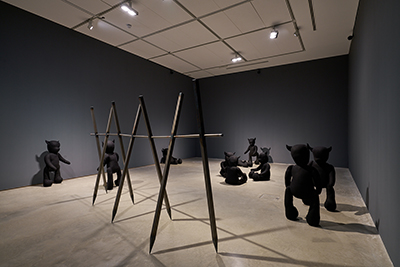
Ten Teddies & Barrier, 2017
Teddy Bears and More
Urvi Kothari
Using everyday objects as a tool for introspection, the visual artist’s solo show explores fundamental issues such as home, migration, identity and safety.
“For nothing is fixed,…
…the earth is always shifting, the light is always changing,
the sea does not cease to grind down rock.
Generations do not cease to be born, and we are responsible to them…”
– A stanza from the poem For Nothing Is Fixed by James Baldwin
American writer and novelist James Baldwin’s poetry runs through my mind as I write about Permindar Kaur’s latest solo exhibition Nothing is Fixed at the John Hansard Gallery in Southampton. Kaur’s show explores dual concepts such as home and migration, the temporary and the permanent, comfort and anxiety. She says, “First, it’s good that things can change and there’s a possibility of growth and movement. But there is also the other side of questioning a place of permanent security. Does this induce a sense of anxiety?”
On entering the gallery, one is overwhelmed by a wall of hiding figures, concealed en masse. Stretching from floor to ceiling in a salon style display, Camouflage looks like a wall covered in vibrant colour-blocked textiles from aquamarine to sunshine yellow, like light shining through a prism. Amidst this extravagant play of colours, the viewer eventually encounters soft sculpture teddy bears – some subtly peeking through the layers of textiles while others stand arm to arm almost looking into the eye of the viewer. “This series in many ways is about ‘fitting in’. In these textile landscapes, where a clawed figure is made from the same material as the background, there is a sense of futility and it’s evident that the figures are hopelessly failing to blend into the surface. They choose to hide out among the colours of their temporary habitat, keeping their spikes as a last-ditch [attempt at] defence,” Kaur says.
“At first, this was an attempt to depict the conflict between my two opposing heritages, Indian and British. Now…I’m exploring what it means to feel [un]comfortable in your surroundings and feelings of home.”
The soft sculptures emit a feeling of rebellion and unease with their elongated witch-like nails, horns forming gothic headgear, left partially unstuffed and limp. Explaining the intent behind this unsettling visual language, Kaur says, “…my work has always been rooted in a sense of insecurity. At first, this was an attempt to depict the conflict between my two opposing heritages, Indian and British. Now, however, perhaps aided by jarring domestic issues and belongings or offbeat figures, I’m exploring what it means to feel [un]comfortable in your surroundings and feelings of home.”
Expanding on the idea of home, the Camouflage series also includes a set of three installations titled India Spain Sweden (2012-2013) Each patterned fabric installation symbolises the three countries that have once been an abode for Kaur. “Spain, where I lived in the 1990s, has a mustard yellow and blue baroque pattern, Sweden is defined by blue and white checks, whilst India, my parents’ home, is patterned in gold and red floral motifs,” she says. Currently residing in the United Kingdom, Kaur humorously adds, “I couldn’t find a fabric that symbolised the UK to me, as maybe it’s too close or I need to leave the country again to find that.”
The extravagant wall display of the Camouflage series links to broader ideas of settlement and migration. Furniture forms an important element within these spaces of dwelling. It functions as a testament to the dwellers’ family lineage through thick and thin. Extending this very idea, Kaur presents the Room of Rooms, a collection of miniaturised furniture that populates the floor space. Reflecting on her long-term interest in the idea of home, her curation presents everyday objects such as beds and chairs in uncomfortable domestic contexts. Untitled Bed is made of a narrow bed frame – barren without a mattress. Beneath this barren furniture, we see colourful pebbles. At a distance, they seem like harmless soft sculptures but on looking closely one encounters sharp spikes hidden within a garden of vibrant flowers in full bloom. Kaur says, “One who comes across these bugs would wonder whether they were friends or foes. Perhaps they are the monsters under the bed so commonly referenced by scared children.”
In a special commission, Hunting Chair (2024), an oversized hunting chair mounted on towering legs sits elegantly, facing large windows overlooking a public square. Kaur says, “With its exaggerated height it feels too perilous to climb. It highlights the precariousness of having to be on guard. On the floor are colourful red flowers representing both a garden or a carpet creating a space that is both interior and exterior.” The installation seems to ask – who is hunting and who is being hunted?
The show culminates with a gallery converted into a closed ecosystem of black teddy bears. Some are seated in isolation in a state of solace, while there are others playfully grouped in a circle. Kaur employs the innocent-looking teddy bears as a tool to reflect on the present. “Someone described the larger teddies as either ‘overgrown children, or devils in training’, which I thought was quite apt,” she says.
Unease and anxiety inform one’s core experience while exploring Nothing is Fixed. In a very playful fashion, Kaur’s teddy bears urge the viewers to ponder and introspect on the fundamental notions of home, identity, migration and protection. She leaves the viewers within the grey area of ambiguity. “There is a story being told, but you don’t quite know the details; the viewer must create their own narrative,” Kaur says.
‘Nothing is Fixed’ is on view at John Hansard Gallery from June 8, 2024 – September 7, 2024.
Urvi Kothari, Inside the White Cube
Published on Aug 10th 2024, Stir Magazine